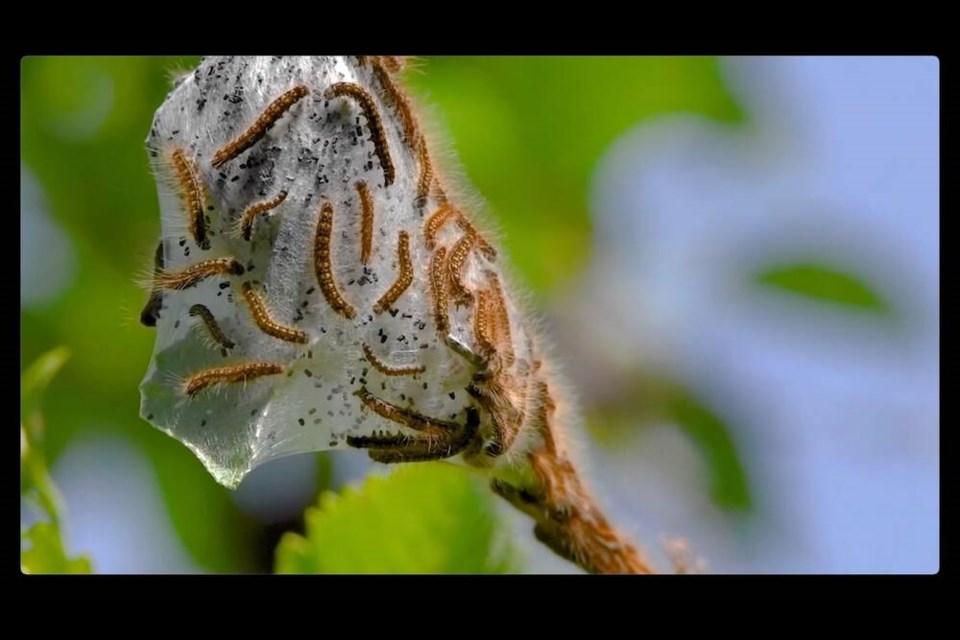If you get weak-kneed at the sight of swarms of tent caterpillars, don’t worry: We’re not in for a massive infestation of the hairy, leaf-munching insects for another few years, according to an expert.
Judith Myers said western tent caterpillars come in big bunches every eight to 10 years — following a fairly predictable cycle of population booms and busts.
Masses of larvae cocooned in silk pouches hanging from trees are not for the squeamish, as they break free and form long lines and clumps on houses, sidewalks and fences, and devour the leaves of fruit trees and other species.
Then, they seem to vanish for years — at least in their large, overwhelming numbers.
Myers, professor emerita in the science and land and food systems faculties at the University of British Columbia, has spent 50 years studying the native moth species and is familiar with their cycles across southern B.C., including her long-time study areas in the Southern Gulf Islands.
She recently published her research in the British Ecological Society’s Journal of Animal Ecology.
Myers said the tent caterpillars never completely disappear; populations are winnowed down, then explode periodically.
“When they are healthy and happy, they can produce a bunch of eggs and increase the population density,” said Myers. “And then their population gets too high. They cause defoliation; they get diseases that spread very rapidly because their population is so high, so their mortality goes way up, and they decline.
“Having that capability of coming back and having a high reproductive rate allows them to resurge, and we go through it all again.”
Over the decades Myers has studied the caterpillars, it has been confirmed that a virus specific to the species was driving the populations’ cyclic declines, something seen in some other moth species. Other bacterial diseases and parasites also contribute to the die-backs, she said.
Myers and her research partner, Simon Fraser University professor Jenny Cory, observed that outbreaks occur simultaneously across the South Island, the Gulf Islands and the Lower Mainland.
“We were surprised to find that, as populations increase, some female moths must fly tens of kilometres to lay their eggs in areas where populations previously went extinct,” said Myers.
When the tent caterpillars appear in large numbers, they can defoliate fruit trees entirely, she said. During a major outbreak in 2012 on Salt Spring Island, the famous fall Apple Festival had to be cancelled.
Myers said tourists visiting the Gulf Islands have been known to cut their visits short during outbreaks.
The last major outbreak in southern B.C. was in 2023. Myers noted Galiano Island and other islands, including Westham Island, were hit especially hard.
“This year, we found just one tent in our study area on Galiano,” said Myers. “That crash is typical, but tent caterpillars will begin to increase gradually over the next six to eight years to reach another outbreak.”
You would think with such large numbers crawling around, the birds would be having a feast. But Myers said birds don’t like them much because of the hundreds of tiny hairs covering the caterpillars.
The hairs can be harmful to horses, which inadvertently eat them while grazing. Cases of the eastern tent caterpillar in Kentucky showed horses that ingested the caterpillar were losing their foals, Myers said.
“Hairs get in the stomach and it irritates the lining and causes a toxic response,” she said.
“Birds sometimes do eat them, but they spend a lot of time getting rid of those hairs,” said Myers. “It’s not worth it to most birds. Sparrows will take some of the early larvae in the spring, but they really don’t like them. It’s not the food source people might imagine.”
The caterpillars have few natural predators, said Myers, noting her research indicated stink bugs seem to like them, and yellow jacket wasps have been known to cut them into smaller pieces and take them back to their nests.
Myers has not seen any effect of global warming on the populations of western tent caterpillars.
”They’re highly adapted to the environment — basking in the sun when it’s cool and sheltering under tents when it’s hot,” she said.
Tent caterpillars favour fruit trees such as apple and cherry, and gravitate to rose and hawthorn rather than maples. The caterpillars are not picky during their swarms, Myers said.
She predicts the next major swarm will begin to appear in four years and reach peak numbers in 2032 or 2033.
Outbreaks can be predicted, and their damage controlled. As numbers begin increasing, forecasting an outbreak can be done three years ahead, Myers said. Start checking in April for small, hairy larvae and silky tents in fruit trees.
To protect your backyard, early intervention helps. If you see egg masses in winter or tiny larvae forming tents in spring, you can remove them before they damage trees.
Commercial fruit growers often use Btk, a safe and effective microbial insecticide. It works best if applied early, before the caterpillars cause significant damage.
“Remember not to panic. The virus acts as a natural control as the caterpillars become overcrowded,” Myers said.



